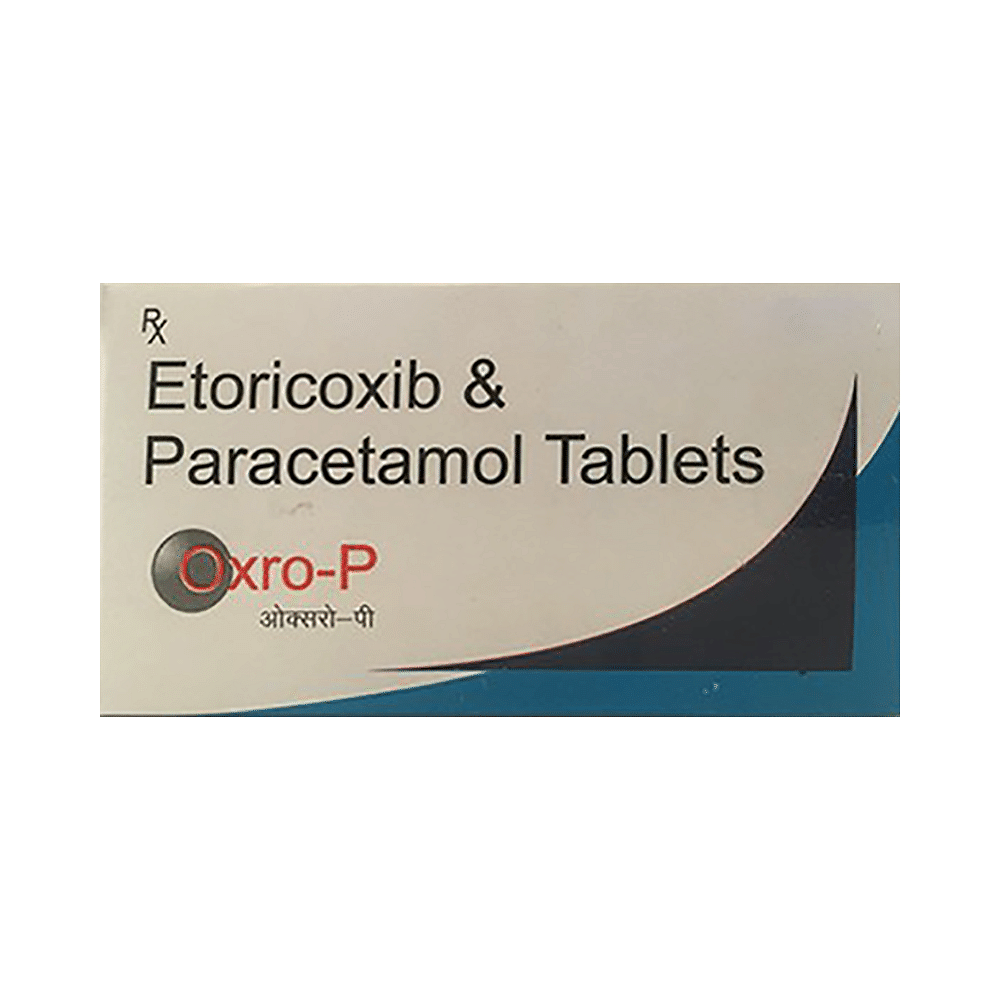
Oxro-P Tablet
Manufacturer
Evershine Lifesciences Pvt Ltd
Salt Composition
Etoricoxib (60mg) + Paracetamol (325mg)
Key Information
Short Description
Oxro-P Tablet is a pain-relieving medicine used to reduce pain and inflammation in conditions like rheumatoid arthritis, ankylosing spondylitis, and osteoarthritis.
Dosage Form
Tablet
Introduction
Oxro-P Tablet can be taken with or without food. You should take it regularly as advised by your doctor. Your doctor may change the dose and time between doses according to your pain level and your needs. Do not take more or use it for a longer duration than recommended by your doctor. Some of the common side effects of this medicine include diarrhea, indigestion, stomach pain, flatulence, swelling of hands and feet, and flu-like symptoms.
Directions for Use
Take this medicine in the dose and duration as advised by your doctor. Swallow it as a whole. Do not chew, crush or break it. Oxro-P Tablet may be taken with or without food, but it is better to take it at a fixed time.
Safety Information
Side Effects
Diarrhea Indigestion Stomach pain Flatulence Swelling of hands and feet Flu-like symptoms
Alcohol Warning
It is unsafe to consume alcohol with Oxro-P Tablet.
Breastfeeding Warning
Information regarding the use of Oxro-P Tablet during breastfeeding is not available. Please consult your doctor.
Pregnancy Warning
Oxro-P Tablet may be unsafe to use during pregnancy. Although there are limited studies in humans, animal studies have shown harmful effects on the developing baby. Your doctor will weigh the benefits and any potential risks before prescribing it to you. Please consult your doctor.
How it works
Oxro-P Tablet is a combination of two medicines: Etoricoxib and Paracetamol. Etoricoxib is a non-steroidal anti-inflammatory drug (NSAID) and Paracetamol is an antipyretic (fever reducer). They work by blocking the release of certain chemical messengers in the brain that cause pain and fever.
Quick Tips
You have been prescribed Oxro-P Tablet to get relief from pain and inflammation. You can take the tablet either with or without food During long-term treatment, your doctor may want to take regular blood tests to monitor your liver function. If you have asthma, symptoms such as wheeze or breathlessness can be made worse by Oxro-P Tablet. If this happens to you, see your doctor as soon as possible.
Frequently asked questions
Can the use of Oxro-P Tablet cause dizziness?
Yes, some patients may experience dizziness (feeling faint, weak, unsteady, or lightheaded) when taking Oxro-P Tablet. If you feel dizzy or lightheaded, rest and resume taking the medication only when feeling better.
Are there any specific contraindications associated with the use of Oxro-P Tablet?
Oxro-P Tablet is not suitable for individuals with known allergies to painkillers (NSAIDs) or components/excipients. Additionally, its usage should be avoided in patients: - With a history of stomach ulcers or active, recurrent gastric ulcer/bleeding. - With a history of heart failure, high blood pressure, or liver/kidney disease.
Can the use of Oxro-P Tablet cause kidney damage?
Long-term use of Oxro-P Tablet may increase the risk of kidney damage. Prostaglandins, a chemical produced by the kidneys to protect them from damage, are lowered by painkillers. This can lead to kidney damage over time. Individuals with pre-existing kidney disease should avoid using this medication.
Will Oxro-P Tablet be more effective if taken in higher doses?
No, increasing the dose of Oxro-P Tablet will not improve its effectiveness but may lead to increased side effects. If symptoms are severe, consult your doctor for re-evaluation.
Can the use of Oxro-P Tablet cause liver damage?
Oxro-P Tablet contains paracetamol. Paracetamol can be harmful to the liver when taken in doses exceeding the recommended level. It's also important to avoid alcohol while taking this medication, as it may further increase your risk of liver damage. Individuals with pre-existing liver disease should use Oxro-P Tablet with caution and consult a doctor immediately if any early signs or symptoms of liver damage occur. These can include fever, rash, loss of appetite, nausea, vomiting, fatigue, stomach pain, dark urine, yellowing of skin or eyes, and abnormal liver enzyme levels.
What are the instructions for storage and disposal of Oxro-P Tablet?
Store this medication in its original container/packaging and tightly closed. Follow the storage instructions mentioned on the label. Do not consume any leftover medication. Ensure pets, children, and other individuals do not have access to it.
Can I stop taking Oxro-P Tablet when my pain is relieved?
If you're using Oxro-P Tablet for long-term pain relief, your doctor will advise on the duration of treatment. However, if you are only using it for short-term pain relief, stopping once the symptoms have subsided may be okay.


